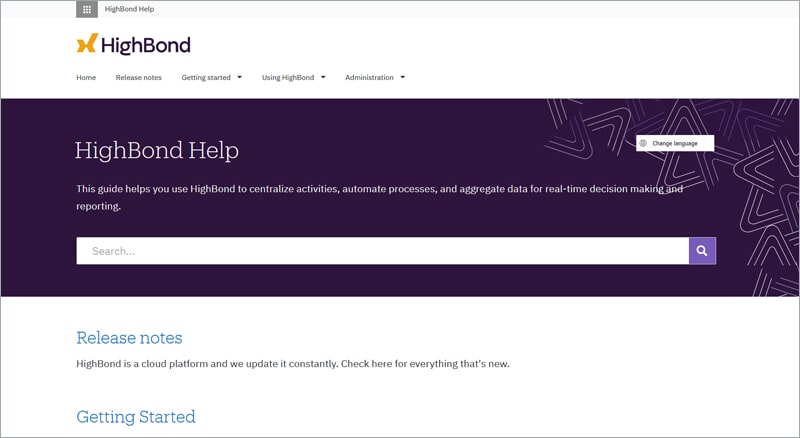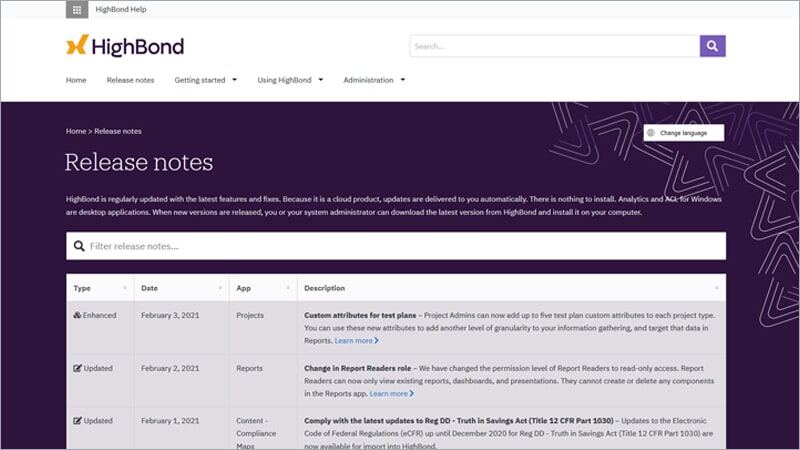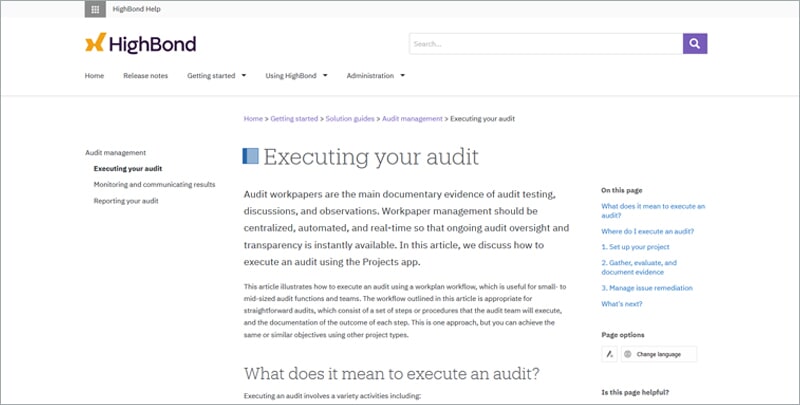Customer Success Story
Leading Governance, Risk and Compliance SaaS Provider Galvanize Facilitates Self-Support for its Customers Worldwide via Localized Documentation Websites with MadCap Software
Goals
- Align documentation with the role-based approach of Galvanize’s HighBond GRC SaaS platform.
- Facilitate customer self-support through intuitive web documentation and online help.
- Keep pace with weekly releases of the HighBond GRC SaaS platform.
- Deliver high quality localized content in six languages to support Galvanize’s worldwide customers.
Benefits
- Role-based documentation: Conditions, variables, snippets and TOCs in MadCap Flare enable Galvanize to produce six product-based documentation sites in seven languages.
- Documentation that facilitates self-support: Micro content, search functionality, and context-sensitive Help in MadCap Flare have led to a 43% increase in customers’ use of the documentation sites.
- Streamlined content delivery: Content reuse facilitated by MadCap Flare and the flexibility to support technical writer’s preferred authoring enables the team to match documentation to the product release schedule.
- High Quality Localized Content: Quality assurance features and tight integration between MadCap Lingo and Flare enable Galvanize to deliver superior localizations while eliminating translation redundancies.
MadCap Software Solutions and Services:
When it comes to managing governance, risk and compliance (GRC), more than 6,300 organizations in 130 countries rely on Galvanize to gain visibility into their risk; demonstrate compliance; and grow their audit, risk, and compliance programs without incurring extra costs. Recognized as a leader by the world’s top analyst research firms, Galvanize provides the only cloud-based GRC platform to unite the objectives of audit, risk, and compliance professionals through data. Today, it is the GRC software-as-a-service (SaaS) provider of choice for many Fortune 1000 and S&P companies, along with banks, manufacturers, healthcare businesses, and government organizations.
The Galvanize HighBond SaaS platform brings everyone together in one spot, so enterprises can ensure that all risks are identified and that the organization is addressing both its internal and external compliance obligations. Users can take full advantage of this business-critical platform in their languages of choice thanks to Galvanize’s modern documentation website that presents information in seven languages. The company develops, localizes and publishes this content using MadCap Flare for single-source content creation and MadCap Lingo for translation management of the content.
Delivering Documentation for an Integrated GRC Platform
In the past, Galvanize produced documentation for each module that it offered, which reflected the software architecture but not the day-to-day needs of users. However, the company decided to rethink its approach to documentation in 2019 when the company rearchitected its cloud offering into HighBond. A single, comprehensive GRC platform, HighBond gave users access to the features they needed and terminology they expected, based on their roles. To support the new platform, the technical writing team shifted to a focus on producing documentation by product that would be available via a single help site, so customers had ready access to all of the information they needed.
Previously, the content was structured as a parent Flare project with two child projects. But, with the rollout of the HighBond platform, the team decided it logically made sense to consolidate the two child projects into a single MadCap Flare project that contained their content in one location. The result is a single MadCap Flare-based project for six HighBond platform documentation sites, AuditBond Help, ControlsBond Help, RiskBond Help, FraudBond Help, ComplianceBond Help, and a more generic HighBond Help. Much like the products that comprise the HighBond platform, each site runs on the same basic framework, but is tailored for the kinds of activities and terminology that each audience expected to see.
“Fundamentally the content isn’t terribly different underneath the covers, but our updated documentation still needs to target what people expect to see based on what they are getting in the applications,” explains Ian Alton, manager of technical writing at Galvanize.
Galvanize continues to maintain the parent project, but it has evolved to become a global project in MadCap Flare that is primarily used to manage elements, such as page layouts and cascading style sheets (CSS).
Keeping Pace with Agile Development
The HTML5-based English-language documentation sites powered by MadCap Flare include nine sites to support traditional desktop applications in addition to the six documentation sites for the HighBond platform. Because Galvanize offers cloud-based solutions, the company primarily focuses on delivering information via the web as well. However, the company also maintains four series of limited-run PDFs that target situations where someone’s Internet access may be limited. To ensure that content keeps pace with updates to Galvanize’s SaaS offerings, the technical writing team relies extensively on the many content reuse capabilities of MadCap Flare.
Because Flare has a robust system of conditions, variables, snippets, and tables of contents, we can essentially write content once, and then make it substantively different when used in different contexts and by different audiences.
Ian Alton Manager, Technical Writing, Galvanize

“Because Flare has a robust system of conditions, variables, snippets, and tables of contents, we can essentially write content once, and then make it substantively different when used in different contexts and by different audiences,” Ian notes. “At the same time, we try to match the release of documentation with the release of product features. Flare has made the content easy to update even when working on an agile SaaS schedule, and generally we’re zero sprints behind our developers.”

Today, MadCap Flare powers nine sites to support traditional desktop applications in addition to six documentation sites for the HighBond platform.
Our Help sites encompass hundreds of topics and, in the PDF versions, thousands of pages. I can’t imagine trying to manually manage the giant network of cross-references and links. Flare’s automated tracking and updating of all those associations is critical to keeping our network of links healthy, and to giving us more time for creating user value with content.
Lachlan Murray Senior Technical Writer, Galvanize

Lachlan Murray, a senior technical writer at Galvanize adds, “Our Help sites encompass hundreds of topics and, in the PDF versions, thousands of pages. I can’t imagine trying to manually manage the giant network of cross-references and links. Flare’s automated tracking and updating of all those associations is critical to keeping our network of links healthy, and to giving us more time for creating user value with content.”
Notably, MadCap Flare is based on the industry-standard Extensible Markup Language (XML) which gives the technical writing team flexibility in two ways. First, the team has been able to create custom CSS and JavaScript in addition to utilizing the extensive capabilities in MadCap Flare.
“Flare is an impressive tool chest. I'm still discovering what some of the drawers contain,” Lachlan says. “The output options and the range of capabilities mean that we can usually extend our offerings without needing an add-on tool or a customized integration.”
A second benefit is that the technical writers at Galvanize can readily work either in MadCap Flare or GitHub.
We like the flexibility to support our technical writers’ preferences, and Flare handles it nicely.
Ian Alton Manager, Technical Writing, Galvanize
“The fact that we have the interoperability to use either GitHub or Flare without them having knowledge of each other really speaks to the good, generic architecture that Flare is built on,“ Ian says. ”We like the flexibility to support our technical writers’ preferences, and Flare handles it nicely.”
Creating a Superior User Experience
Galvanize also puts a priority on creating a superior user experience (UX) for customers, whether they are using the HighBond platform or seeking information from one of its online documentation sites. All of the sites feature a responsive design and are mobile-friendly with different breakpoints for mobile, tablet and desktop devices. Meanwhile, expandable and collapsible text gives the web pages a clean, modern look while enabling users to dive into added detail as needed. Additionally, Galvanize has added custom code to enhance its documentation pages.
So often there are little details that ordinarily would be missed, but with Flare it’s just so easy to write a few lines of JavaScript or jQuery to add the functionality we want.
Ian Alton Manager, Technical Writing, Galvanize
“When an image spills outside of its containing element, we dynamically shrink it and then enable a light box on it so users can zoom into it. We've implemented filters on some of our content, and we set the focus to the search box automatically when the home page loads,” Ian observes. “So often there are little details that ordinarily would be missed, but with Flare it’s just so easy to write a few lines of JavaScript or jQuery to add the functionality we want.”

MadCap Flare allows HighBond to write content once, and then leverage it across various contexts or audiences for maximum efficiency.
Enabling users to easily find the information they need is another top priority. Galvanize makes extensive use of context-sensitive Help (CSH) identifiers to present tooltips with “learn more” links right in the software, which take the user directly to the appropriate page with more detail. The technical writers have also taken advantage of search engine optimization, particularly with synonyms and keywords, to help close terminology gaps. And using the micro content functionality in MadCap Flare, the team now makes it possible for customers to see the answers to their questions appear as the top search results.
Another great feature is that we have our glossary integrated into the search, so when users search for glossary terms, they’ll get a nice definition. We really like how easy it is to enhance the overall UX with Flare.
Ian Alton Manager, Technical Writing, Galvanize
Localizing Content in Six Languages
For Galvanize, creating a superior customer experience also means providing information in customers’ language of choice. Currently, this means translating the company’s English-language content into Spanish, French, German, Portuguese, Chinese and Japanese. Galvanize relies on a global network of 40 external translation professionals, who are managed by the company’s localization team. To facilitate these translations, the company relies on MadCap Lingo, which is tightly integrated with MadCap Flare.
When the technical writing team produces new content in MadCap Flare, the localization group uses MadCap Lingo to identify and package the content that has changed and send it to the translators. Not only is this significantly easier than trying to track changes in a Microsoft Excel spreadsheet as the technical writing team had in the past; it also serves to eliminate redundancies in the translation effort.
Even as the documentation has grown more complex with the introduction of our HighBond platform, we’re still completing localizations just as quickly with MadCap Lingo and Flare.
Cristina Jimenez Localization Engineer, Galvanize

“One of the benefits with MadCap Lingo is that it's a native tool for localizing Flare, which definitely makes it easier to localize content that takes advantage of Flare’s features,” observes Cristina Jimenez, a localization engineer at Galvanize. “Even as the documentation has grown more complex with the introduction of our HighBond platform, we’re still completing localizations just as quickly with MadCap Lingo and Flare.”
There are a number of QA processes that are automated in MadCap Lingo, which help us to identify any issues and produce higher quality localized content.
Alexander Mccate Localization Manager, Galvanize


When the HighBond technical writing team produces new content in MadCap Flare, the localization group uses MadCap Lingo to identify and package content that has changed so they can send it out to translators.
Quality assurance (QA) is another benefit of the tight integration between the two MadCap Software products. Once translators have returned the localized content, the Galvanize team merges them into MadCap Lingo before importing them back into MadCap Flare.
The ability to flatten variables is probably the biggest advantage of MadCap Lingo because it enables us to significantly improve the quality of our localizations.
Alexander Mccate Localization Manager, Galvanize
Finally, the localization team makes extensive use of the ability to flatten variables with MadCap Lingo. Previously, variables in the English language content often presented a challenge, since they didn’t necessarily align neatly with the grammatical structure of other languages. Now with MadCap Lingo, the localization team can send translators the exact text of a sentence without the variable.
Empowering Self-Support
Since rolling out the new documentation sites for the HighBond platform, Galvanize has seen measurable gains in customers’ ability to get answers to their questions.
Overall, sessions with the Help websites were up 43%, and the average time users spent on a page was up 13.8%. At the same time page views per session were down 25%. Taken together, the stats indicate that customers are getting the specific pages they need faster and getting the level of detail they need once they get there.
Similarly, searches per session were down 21% while the search result clickthrough rate was up 23%, suggesting more accurate search results that are quickly getting customers to the information they need.
“We recently added a feedback form to our Help sites, and to date, 63% are responding ‘Yes’ when asked, ‘Was this helpful?’, Ian observes. “It’s part of a general trend we're seeing that people are finding answers more quickly, and they are engaging with the content more than they ever had before.”
Even when customers can’t troubleshoot on their own using the documentation, it provides a valuable frame of reference when talking with a Galvanize service representative.
“The documentation features prominently in some of our internal support questions. So, when support has a question for one of our product designers, typically that question will also include a reference to a support article,” Ian explains. So, now discussions are along the lines of, ‘I'm seeing this in the documentation, but this is the behavior I'm seeing.’ It really factors into people's troubleshooting processes, and it’s pretty highly regarded within our organization.”
A hallmark of cloud computing is the ability for customers to get up and running quickly and easily. The documentation and Help sites we’re delivering with the solutions from MadCap Software are playing an important role in delivering this value to customers of our HighBond platform.
Ian Alton Manager, Technical Writing, Galvanize





